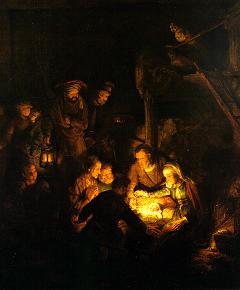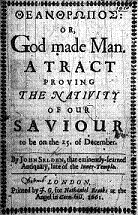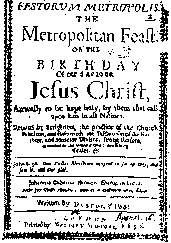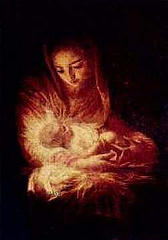“In the East” or “In Its Rising?”
The Star of the Magi and How Trendy New Versions Distort Matthew’s Gospel
In this article, we address the question
whether magi saw the star “in the east” according to traditional
translations, or, according to modern, trendy translations, the
magi saw the star “in its rising?” We will conclude that the
traditional, historical translation is correct, and that modern
translations distort the meaning of Matthew’s Gospel.
According to Matthew,
When Jesus was born in Bethlehem of Judea in the days of Herod the king,
behold, there came wise men from the east to Jerusalem, saying
Where is he that is born king of the Jews? For we have seen his
star in the east, and are come to worship him. Matt. 2:1, 2
There are two references to the “east” in
this passage: the first occurs in a clause pertaining to the
wise men or magi; the second occurs in a clause spoken by the
magi about themselves and also includes reference to the star.
The first is clear and unambiguous, and identifies the magi’s
place of origin: “magi came from the east.” However, the second
is ambiguous and can be understood either in reference to the
magi or the star. If to the magi, it refers (as before) to the
region or country where the magi were when they saw the star
before travelling to Jerusalem. If to the star, it can refer
either to 1) the place or quarter of the sky in which the
star was viewed or seen, or (if new versions are credited) to 2)
the time and manner of its appearing; viz., it’s
heliacal or
acronychal
“rising.” Translations which have it that the star is referred to
typically opt for the latter, and render the passage “For we
have seen his star in its rising, and are come to worship
him.” This requires explanation.
Heliacal and Acronychal Risings
All stars, as the earth makes its annual orbit around the sun,
appear to migrate across the sky, rising first in the east, then
moving slowly toward the west, where they disappear below the
horizon, only to reappear sometime later in what is termed their
heliacal rising – the
first day, after being invisible, when they appear again on the
eastern horizon in advance of the morning sun. Due to their
proximity to the sun at their heliacal rising, stars disappear
at sun-rise due to the sun’s overwhelming brightness. However,
with each passing day the star rises earlier and earlier,
gradually rising several hours before dawn, then at midnight,
until finally it is seen to rise in the evening twilight. This
is called its acronychal rising - the last day when a
star, after being visible at night, rises in the evening
following sunset, the sun being far enough below the western
horizon to allow the star to be seen on the eastern horizon in
the evening twilight. This is the point at which the star is
visible the longest duration in the night sky. Thereafter, with
each passing day the star’s duration in the night sky will grow
shorter. Each day the star will rise earlier and earlier, the
sun still being in the sky, the star becoming visible only after
sunset where it appears progressively higher above the eastern
horizon advancing toward the western sky. This process will go
on until the star’s heliacal setting, which is the last
day after being visible that it appears briefly in the western
sky just after sunset before dipping below the western horizon.
Thereafter, it will not be seen again until its heliacal rising,
when it appears briefly in the morning sky just before dawn, and
the process begins again.
Versions that translate Matthew 2:2 (cf. v. 9) “in its
rising,” have the above astronomical phenomena in mind.
Historically “In
the East” is Favored Two-to-One
Historical accident has it that the Greek term for “east” is “the
rising” (singular -
ַὰνατολή
/ plural -
ὰνατολῶν) and for “west”
is “the setting” (δυσμή/δυσμῶν).
Latin is similar, “east”
being oriens (“rising”) and “west” being occidens
(“setting”). It is from the Latin that we get our English terms
“oriental” and “occidental” to refer to the respective regions
of the globe; viz., the east where the sun rises and the
west where it sets. However, we do
ַnot
translate the Greek (or Latin) literally when we encounter these
terms because it would be bad English to say there came “wise
men from the rising [of the sun],” or “many shall come from the
setting [of the sun]”
(Matt. 8:11). Instead, we translate these terms according to their common
English names “east” and “west.” This is historically true.
A survey of over 50 English translations shows that the preferred
rendering is “in the east” better than two-to-one over “in its
rising.”[1]
Translations opting for the latter are largely newer
paraphrastic or dynamic equivalence translations that are less
conscientious about reflecting the actual Greek of the inspired
New Testament, the majority of which were published in the last
ten to twenty years. Older editions such as the Wycliff Bible
(1400), the Tyndale (Matthews) Bible (1537), the Great Bible
(1540), the Bishop’s Bible (1568), the Geneva Bible (1560), the
Authorized (King James) Version (1611), the Rhemes New Testament
(1621), the Challoner New Testament (1749), Young’s Literal
Translation (1862), the Revised Version (1881), the Douay-Rheims
(1899), and the American Standard Version (1901), to name but a
few, uniformly render the phrase “in the east.” To these may be
added the ancient and venerable Syriac Peshitta (AD 180),[2] and
Jerome’s Vulgate (AD 382), and doubtless many, many more. It is
therefore clear that from the dawn of Christianity most scholars
have rendered the phrase “in the east.” “In its rising” does not
turn up until modern times (1961), and then only in trendy, less
reliable, commercially produced translations.
Table
of Translations
|
In the east |
|
Rising in the
east |
|
In its rising |
|
1.
Wycliff - 1400 |
|
|
|
|
|
2.
Tyndale - 1537 |
|
|
|
|
|
3.
Great Bible – 1540 |
|
|
|
|
|
4.
Bishops – 1568 |
|
|
|
|
|
5.
Geneva - 1560 |
|
|
|
|
|
6.
AV (KJV) - 1611 |
|
|
|
|
|
7.
Rhemes - 1621 |
|
|
|
|
|
8.
Challoner - 1749 |
|
|
|
|
|
9.
Young’s Literal - 1862 |
|
|
|
|
|
10.
Darby - 1890 |
|
|
|
|
|
11.
Revised - 1889 |
|
|
|
|
|
12.Douray-Rheims - 1899 |
|
|
|
|
|
13.
ASV - 1901 |
|
|
|
|
|
14.
RSV - 1946 |
|
|
|
|
|
15.
Phillips - 1958 |
|
|
|
|
|
16.
Amplified - 1965 |
|
|
|
|
|
17.
TLB - 1971 |
|
|
|
|
|
18.
NKJV – 1982 |
|
1.
GNT - 1976 |
|
|
|
19.
NLV - 1986 |
|
2.
ETRV - 1987 |
|
1.
NET - 1961 |
|
20.
NCV - 1987 |
|
|
|
2.
AMPC - 1965 |
|
21.
ICB - 1991 |
|
|
|
3.
WE - 1969 |
|
22.
NASV – 1991 |
|
|
|
4.
NIV - 1978 |
|
23.
MSG - 1993 |
|
|
|
5.
NRSV - 1989 |
|
24.
NIRV - 1996 |
|
|
|
6.
GW - 1995 |
|
25.
CJB - 1998 |
|
|
|
7.
NLT - 1996 |
|
26.
KJ21 - 1998 |
|
|
|
8.
ESV - 2001 |
|
27.
JUB - 2000 |
|
|
|
9.
CSB – 2003 |
|
28.
WEB - 2000 |
|
|
|
10.
Mounce - 2008 |
|
29.
OJB - 2002 |
|
|
|
11.
LEB - 2010 |
|
30.
DLNT - 2002 |
|
|
|
12.
NOG - 2011 |
|
31.
HCSB – 2003 |
|
|
|
13.
NABRE - 2011 |
|
32.
Voice - 2012 |
|
|
|
14.
EXB – 2011 |
|
33.
CEB - 2011 |
|
|
|
15.
EHV 2014 |
|
34.
MEV - 2014 |
|
|
|
16. TPT - 2015 |
Greek Points to
the Magi, Not the Star
So much for English translations, let us look at the Greek. There
are two references to the east in Matthew 2:1, 2. The first
describes the magi coming from the east and is plural; the
second, refers to the place where the star was seen or viewed
and is singular. Here are the relevant phrases in Greek,
followed by their English translation, as they appear in
Matthew. Naturally, in translating to English the word order
will normally need to be corrected, but are preserved here in
their original order, the words numbered to match the Greek with
their respective English equivalents:
1 μάγοι
2
ὰπὸ
3
ὰνατολῶν - 1 magi 2 from 3 the east (plural)
1
εἴδομεν
2 γὰρ
3 αὺτοῦ
4 τὸν
5
ὰστέρα
6
ὲν
7 τῆ
8
ὰνατολῆ -
1 we saw 2 for 3 his 4 the 5 star 6 in 7 the 8 east (singular)
The two terms for “east” in the passage above are
anatolwn (plural) and
anatole (singular).
The first reflects the perspective of those in the west or other
region as they view the vast expanse of eastern lands and
peoples; hence the plural. “Magi came from the east;”
viz., from lands and
peoples toward the rising of the sun. Use of the plural in this
context is clear and understandable and makes perfect sense.
Indeed, although English does not have plural forms for north,
south, east, and west, the plural is sometimes implied, as when
we speak of the “far east,” which implies a vast area
encompassing many nations, or the “west,” referring to the
nations of western Europe, etc.
The second occurrence appears to reflect the perspective of
individuals as they view themselves or an object in or facing a
particular place in
the east; hence the singular. “We saw his star in the east;”
viz., while the magi
were in their homeland. Since, from the magi’s point of view
they are referring to a particular place in the east, use of the
singular is quite understandable. A comparable case for speakers
of English might be to say in reference to the British Isles,
“there came men from the Isles” (plural). But the men explaining
why they had come from their particular island would say “we saw
his star from the isle and have come hither” (singular). Here
are several additional examples from the Greek New Testament and
Septuagint (Greek Old Testament) to demonstrate the point:
Plural
·
1
πολλοὶ 2
ὰπὸ 3
ὰνατολῶν 4 καὶ 5 δυσμῶν
– 1 many 2 from 3 the east 4 and 5 the west (Matt. 8:11).
·
1
ὰπὸ 2
ὰνατολῶν 3 καὶ 4 φαίνεται
5
ἔως 6 δυσμῶν – 1 from 2 the east 3 and 4 shines 5 unto 6 the west (Matt. 24:27)
·
1
βασιλέων 2 τῶν 3
άπο 4
άνατολῶν 5
ήλίου – 1 kings 2 the
3 from 4
rising 5 of the sun
(Rev. 16:12)
These examples show that where the eastern expanse embracing many
lands and peoples toward the sunrise (or sunset) is in view, the
plural is used.
Singular
·
1
άπ 2
άνατολῆς
3 πυλῶνες 4 τρεῖς
– 1 on 2 the east 3 gates 4 three (Rev. 21:13)
·
1 καὶ 2 τὸ 3 κλίτος 4 τὸ 5 πρὸς 6
ἀνατολὰς – 1 and 2 the 3 side 4 the 5 toward 6 the east
(Ex.37:11)
·
1
παρὰ 2 τὸ 3 θυσιαστήριον 4 κατὰ 5 ἀνατολάς – 1 by 2 the 3
altar 4 against 5 the east (Lev. 1:16)
·
1
πρὸς 2 ἀνατολὰς 3 κατέναντι – 1 toward 2 the east 3 facing (II Chron. 4:10)
·
1
τὸ 2 κλῖτος 3 τὸ 4 πρὸς 5 ἀνατολὰς –
1 the 2 side 3 the 4 to 5 the east (II Chron. 29:4)
·
1
τῆς 2 πύλης 3 τῆς 4 ἀνατολῆς – 1 the 2 gate 3 the 4 east (Neh.
3:29)
·
1 πύλην 2 τὴν 3 πρὸς 4 ἀνατολάς. – 1 gate 2 the 3 toward 4 the east
(Ezek. 8:5)[3]
These examples show that where a specific location is contemplated,
such as the curtains of the tabernacle (Ex. 37:11), or the side
of the altar (Lev. 1:16), or the place of the brazen sea (II
Chron. 4:10), or a particular gate, the singular occurs.
If this is correct, since
anatole is singular, the magi’s statement they had seen the
star en te anatole would not
mean they saw the star in the vast expanse of eastern sky, for
here we would expect the plural. Rather, the magi saw the star
while they themselves
were en te anatole; that is, in their own eastern country. In other words,
en te anatole describes the origin and location of the magi,
not the star!
Context Favors
Traditional Rendering
That this is correct is apparent from the context and the fact that
the magi were explaining
why they came to Jerusalem from the east. The magi saw a
star in the east but have travelled west to Judea. Why? Their
explanation only makes sense if they were in effect saying, “we,
being in the east, saw his star here in the west, and therefore
have come hither.” That they saw the star in the west again when
they departed from Herod (Matt. 2:9) tends to confirm that this
is so and that the star is never referred to as having
been the eastern sky at all.
Note also, that had it been Matthew’s purpose to indicate the magi
saw the star helically rising, there were ways he could have
unambiguously conveyed this idea. For example, Mark 16:2
mentions the “rising of the sun” (άνατείλαντος τοῦ
ὴλίου). If
Mark can say “rising of the sun,” certainly Matthew can say
“rising of the star” in language that is comparably unambiguous.
Similarly, John says “And I saw another angel ascending from the
east” (άναβάντα
άπὸ
ὰνατολῆς
ήλίου) - literally, “having ascended from the rising of the sun” (Rev.
7:2). If John can say he saw an angel ascending from the
rising of the sun, Matthew is capable of saying the magi saw a
star rising from the sun. Since Matthew does not use
comparable terminology, we may safely conclude the heliacal
rising of the star was not mind.
Incentive to Create a New Translation
If the Greek and translational history weigh against “in its
rising,” why create a new translation of the passage at all?
First, there is a proprietary incentive in creating new
translations. Commercialization of God’s word is an unavoidable
and unhappy product of the freedom of the press, and is
certainly one of the driving forces behind new translations;
every publishing house wants a piece of the action and require
distinctive readings to make their product unique and
attractive. Second,
students and
scholars tend to adopt the conclusions of their peers as being
the safest choice regarding a question they have not personally
studied themselves. We cannot all be experts on every question
confronted with, so we follow prevailing trends under the
assumption they represent the most up-to-date scholarship. This
is why other historically correct translations such as “only
begotten” (μονογενὴς) tend to be left behind by new versions in favor of
incorrect, modern translations like “one and only” or “one of a
kind,” etc.[4] “Monkey see,
monkey do.” Others are using that translation, so we do too, as
risk of appearing uninformed. Third,
and perhaps more to the point, among astrologers the heliacal rising
of a star had a certain predictive value used in constructing
horoscopes and interpreting the stars and sky. Since magi were
associated with astrology from Babylonian times, some suppose
pagan astrological traditions should be inferred from the magi’s
presence in the narrative. They then impose this supposition
upon the passage and translate the text accordingly.[5] However,
the premise underlying this supposition is unsound.
Were the Magi
Pagan?
Although magi were historically involved in astrology and similar
mystic arts, no pagan would have made the long journey from the
east to Jerusalem to worship the new-born Christ unless he was
also a worshiper of God. The magi therefore were almost
certainly proselytes of the Jewish religion. It will be recalled
that, during the captivity, the prophet Daniel was made master
of the Chaldeans and magi by Nebuchadnezzar (Dan. 2:48; 4:8, 9;
5:11), and Nebuchadnezzar himself became a worshipper of God
(Dan. 4:37). Given Daniel’s prominence in the Babylonian court
and Nebuchadnezzar’s conversion, it is likely that at least some
of the magi also became proselytes of Judaism. If so, it is
possible that the magi here represent a tradition tracing to the
time of Daniel. Moreover, since the law of Moses forbade
involvement in the mystic arts, including expressly astrology (e.g.,
“observing times,” Lev. 19:26; Deut. 18:14; II Kng. 21:6; Isa.
47:13-14), the inference would normally be against these
magi practicing or giving credence to such things.
Were the magi taught by Daniel to look for a star announcing the
birth of the Messiah based upon Old Testament passages like the
oracle of Balaam or the book of Isaiah or the Psalms? (Num.
24:17; Isa. 60:1-3; Ps. 72:10, 11). This seems very unlikely.
Balaam’s reference to a “Star” that would arise out of Jacob
(Israel) is to Christ himself, not an astronomical phenomenon (cf.
Rev. 22:16). Similarly, when Isaiah said the “Gentiles shall
come to thy light, and kings to the brightness of thy rising,”
he refers to the spiritual light of the gospel and to the glory
that would envelope God’s people, the church, over against the
spiritual darkness enshrouding unbelieving Jews and Gentiles (cf.
Isa. 9: 1, 2; Matt. 4:12-15). That the magi were studying the
stars in expectation of Christ’s birth based upon these passages
of scripture is therefore highly improbable. In the ancient
world, lunar calendars were the norm and required constant
observation of the sky to regulate their rhythm. It is far more
likely that the magi’s interest in the stars was originally
exclusively scientific and calendrical and had nothing to do
with either pagan traditions or shadowy scriptural allusions.
Divine
Revelation or Human Perspicuity?
What does seem clear, however, is that no astronomical phenomenon
could have communicated the birth of Christ to the magi in any
convincing way apart from divine revelation of God.
Otherwise, how could it be known with certainty what, if any,
significance the star possessed? So far as we know and can tell
from Matthew’s account, no one other than the magi even saw the
star, and certainly no one understood its meaning if they did
(Matt. 2:1-3). We know from Matthew that the magi received
divine revelation in a dream not to return to Herod (Matt.
2:12). It is therefore likely that in the two-year period from
the star’s first appearance until Christ’s birth, the magi were
divinely instructed by God regarding both its fact and
significance and that it is this, not astrology, that prompted
the magi’s journey. If so, the heliacal rising of stars would
have been irrelevant to the magi and should not enter into
translation of the text. Doing so distorts the narrative, giving
undue glory to the perspicuity of men, rather than the work and
revelation of God.
Conclusion
The historic translation of Matt. 2:1, 2, 9 is the correct
translation: the magi saw the star while they were in the east
and so travelled west to Jerusalem seeking the newborn Christ,
and that almost certainly based upon divine revelation from God,
and not human perspicuity or pagan traditions regarding the
heliacal rising of stars.
[1] See
https://www.biblegateway.com, accessed Jan. 7, 2018,
for searchable English translations currently in print.
See
https://www.originalbibles.com,
accessed Jan. 7, 2018, for historical editions like the
Wycliff Bible now out of print.
[2]
https://www.originalbibles.com/english-version-of-the-syriac-peshitta-1915-pdf/
https://www.originalbibles.com/a-literal-translation-of-the-four-gospels-from-the-peschito-pdf/
[3] A searchable
copy of the Septuagint is available online at
https://www.ellopos.net/elpenor/greek-texts/septuagint/default.asp;
accessed 1/3/2018.
[4] The Syriac
Peshitta and Latin Vulgate (“unigenitum”), two of the
most ancient translations we possess, both have “only
begotten” at John 3:16.
https://www.originalbibles.com/english-version-of-the-syriac-peshitta-1915-pdf/;
https://www.originalbibles.com/a-literal-translation-of-the-four-gospels-from-the-peschito-pdf/.
“One and only” or “one of a kind” does not appear until
modern times.
[5] See for
example, Colin R. Nicholl,
The Great Christ
Comet (Wheaton, IL, 2015)49-51: “Heliacal rising
could be perceived to have great astrological
significance…Particularly if the Star was within the
zodiac, it was natural for the Magi to consider the
possibility that it might be communicating something of
a natal significance against the backdrop of the
heliacally rising constellation…We suggest therefore
that the Magi were convinced that the Messiah’s birth
was taking place when they saw the Star at or around the
time of its heliacal rising. Evidently, the Magi
perceived significance in the Star’s location within the
constellations, its form, and/or its behavior, and/or in
the time of the heavenly wonder…To that extent, what
they saw was reminiscent of a horoscope.”
______________________________

Adoration of the Shepherds
All rights reserved.
 John Seleden’s
John Seleden’s




